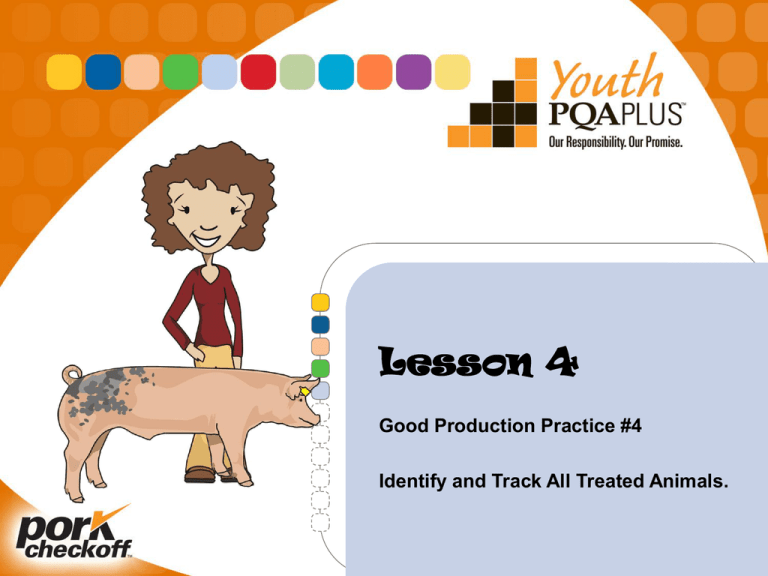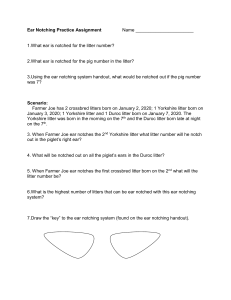Animal Identification
advertisement

Lesson 4 Good Production Practice #4 Identify and Track All Treated Animals. Objectives • This lesson will help you to: – Identify tools and methods for identification of pigs or pens – Explain the importance of identifying and tracking all treated animals Good Production Practice 4 2 Animal Identification • Important management tool • Record performance measurements • Track – Treated pigs – Ownership and movement of pigs – Disease outbreaks Good Production Practice 4 3 Animal Identification • Permanent – Ear notching – Tattoo • Temporary – Ear tag – Paint brand – Animal markers Marking crayon Marking stick Good Production Practice 4 4 Permanent Animal Identification • Ear notching – Right ear Litter number – Left ear Pig number • Read ear notches beginning with litter number – Ex. 23 – 4 Born in the 23rd litter Was the fourth pig identified Good Production Practice 4 5 Permanent Animal Identification Litter Number 1+1=2 Pig Number 3 + 9 = 12 Good Production Practice 4 6 Permanent Animal Identification • Tattoos – Permanent – Hard to read from distance Good Production Practice 4 7 Temporary Animal Identification • Ear tags • Paint brands • Markings using: – Marking crayons or – Marking sticks Good Production Practice 4 8 Animal Identification • Group tracking: – May be used when an entire group of animals have the same withdrawal time Unit may be a pen, room or building – Used in commercial operations Good Production Practice 4 9 Animal Identification • Record the individual identification of any animal that you treat • This will help ensure that you can identify the same animal again Good Production Practice 4 10 Tracking Treated Animals • Animal treatment should be accompanied by a written record • Medication and treatment records – Help ensure food safety throughout the food supply chain Good Production Practice 4 11 Tracking Treated Animals • Medication records Date Sept. 22 Animal ID 145 Product name Penicillin Amount given 10 cc Route IM Given by Chuck Withdrawal time 10 days Good Production Practice 4 12 National Animal Identification System (NAIS) USDA - NAIS • Information system to enhance response to U.S. animal disease events • State/Federal/Industry cooperative effort • Provides oversight and coordination of species-specific program standards for identification – The pork industry has developed the Swine ID Plan Good Production Practice 4 13 Premises Identification Premises Identification Number (PIN) • Key component of NAIS and the Swine ID Plan – Seven alphanumeric characters that uniquely identify a physical location where livestock may be located. • During natural or disease disasters, PINs will support: – Faster traceback capability – Faster determination of the extent of the outbreak or event – Faster implementation of disease control measures and response activities – Better business planning to diminish the effects of an outbreak or event – Better communications to producers in areas affected by disasters Good Production Practice 4 14 Take-Home Message • Learn how to read ear notches • Establish how you will identify your animals • Use identification to aid in keeping treatment records Good Production Practice 4 15 Summary • Identify tools and methods for identification of pigs/pens • Understand the importance of identifying and tracking all treated animals Good Production Practice 4 16 Youth Pork Quality Assurance Plus Good Production Practice 4 17











